So basically, the previous four D&D adventure modules had a very... 'basic D&D' vibe around them. And, sure, at the end of each of them you do fight one of the premier big bads of the D&D setting. The five-headed evil dragon goddess Tiamat; one or more of the elemental princes; and the demon lord Demogorgon. Those four adventures basically jump around some of the potential adventure hooks that the Monster Manual talked about... and so do these three next adventures, albeit centering on different archetypes of fantasy. As always, I'm going to make a concerted effort to talk about the monsters and creatures moreso than the adventure itself.
And... well, not to complain or anything because I really do recognize that these books are adventure modules first and foremost and not bestiaries, but basically a lot of these simply don't add a whole ton of new monsters, huh? Thank goodness for Tomb of Annihilation, which we'll be covering next.
____________________________________
Curse of Strahd
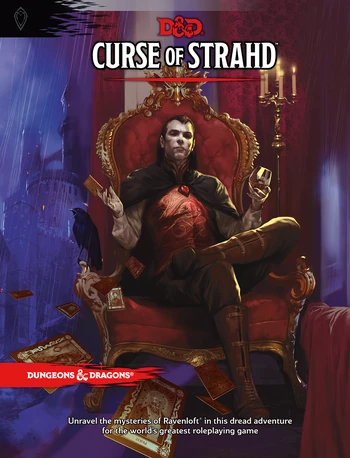
So we've got dragons and dragon cults; elementals and elemental cults; plus demons in the Underdark. The next huge sort of villain? The undead, of course. Instead for going for a lich or whatnot, though, we go for a very gothic vibe by having a vampire-themed adventure, a neat, far cry from the more sword-and-magic quasi-medieval-fantasy fare that D&D typically runs on. And unlike most of the previous adventures, Curse of Strahd is a bit more... sandbox-y. I'm not that great at reviewing D&D adventure modules, but I'm told that Curse of Strahd is a fun little sandbox adventure limited into a relatively small area, and the plot basically have you go around, gathering allies and taking down Strahd's minions before taking down the huge vampire count himself. Pretty cool, but the mood and the general gothic-horror vibe is really what makes this module feel so memorable compared to many of the others. I've seen a lot of people say this is their favourite 5E adventure and, hey, gothic horror is cool! I've also seen some people take issue with the Romani-inspired vibe of the vampires, which... I haven't actually read the book, so I'll not comment on that. On with the monsters!
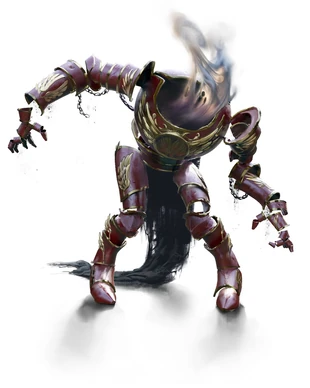

Animated Objects
Only "Strahd's Animated Armor" gets artwork, but in addition to that we've got the "Broom of Animated Attack", the "Guardian Portrait" and what I think is a boss of sorts, "Baba Lysaga's Creeping Hut". Poltergeists and objects moving around without anyone touching them has been a longtime trope of horror, so it's neat that they bothered to give them stats and unique abilities. They could've just copy-pasted the generic Animated Object entry from the Monster Manual, but hey, these are pretty cool! I do really like the description where the Broom of Animated Attack actually pretends to be a helpful (and thematic to the witches-and-vampires setting) flying broom before beating the shit out of you. The Guardian Portrait is like something out of Harry Potter, a portrait whose eyes follow you around. They can't actually hurt you (they are frame pictures on the wall) but what they can do is cast Crown of Madness on your face. Strahd's Animated Armor is... it's got plot significance, and the artwork is very cool (the parts of the armour are actually disconnected and floating!) but it's just a headless piece of armour with a ghostly head. Cool, but nothing that really super-duper appeals to me.
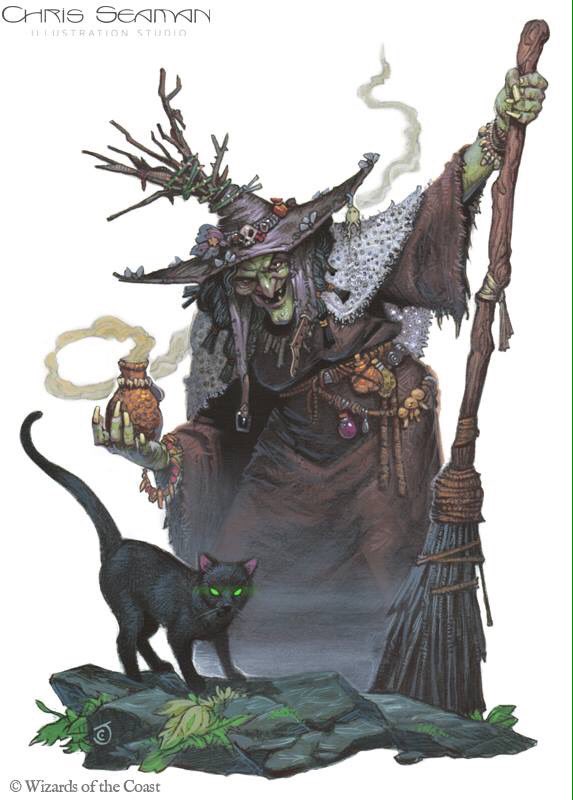
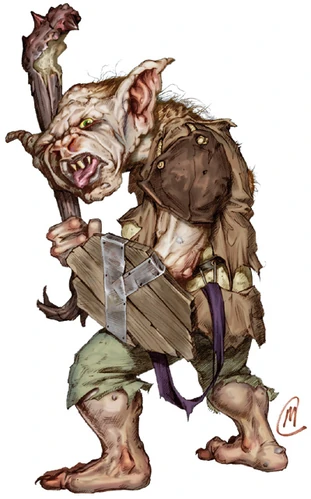
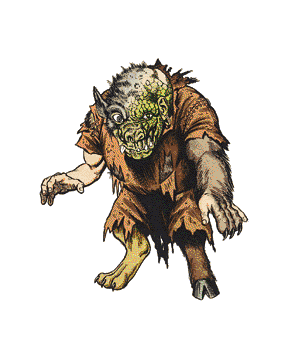
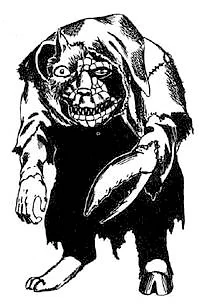
Mongrelfolk
Okay, visually, the 5E Mongrelfolk (a mongrel is a mixed-breed dog) doesn't look particularly interesting. Just some sort of more hideous-looking goblin that, if you didn't tell me, I wouldn't realize that it was meant to be a unique race instead of just a particularly ugly goblin creature. And then you read the description, and the Mongrelfolk are apparently humanoids whose ancestors were transformed via horrific magical transformations into chimera-esque beings with bodies that incorporate the features of various beings -- with, as Curse of Strahd describes, some variants having 'the body shape of a dwarf but the head that combines a cat and a lizard, a hand of a crab, a leg that ends in a hoof', or 'the skins and horns of a cow, the eyes of a spider, frog's legs and a lizard's tail'. That sounds so nasty and awesome, and instead what we got it Dobby's clothed brother.

Phantom Warrior
I guess none of the various ghosts and specters of 5E's Monster Manual fits this guy's niche? The Phantom Warrior is a more simple ghost enemy. Where most of 5E's ghosts tend to revolve more around its intangibility or ability to possess you, the Phantom Warrior is content to just beat you to death with his sword. Noted to be created from the souls of warriors who fell on duty, the Phantom Warrior is a spirit that lingers on to willingly serve its master, as opposed to the 'trapped by an unresolved goal' that D&D ghosts have. It can apparently end its undead existence and pass on at any time, with the example given in the bestiary entry noting of a Phantom Warrior guard that continues to guard a wall might pass on after a new guard arrives to relieve him, or if the wall is destroyed. Being a lingering spirit it still doesn't quite have the same amount of memory as a living person, but I do like that as confusing as the names can be, there are a fair amount of different types of undead tossed around that feels like it's built to have roleplay opportunities.
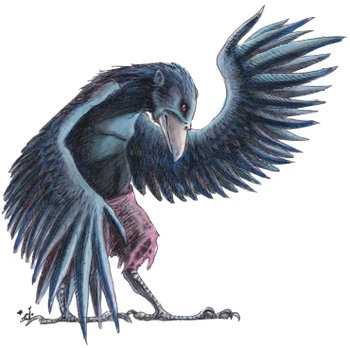
Wereraven
Another one that doesn't have artwork (this one is from 2E) is the Wereraven. Ravens are very appropriate creatures to show up in a horror-themed setting. So are lycanthropes! So yeah, Wereravens exist. They don't quite appear as often as I thought they would, mostly because mammalian lycanthropes are more popular, and Kenkus exist. They're pretty neat as adversaries or NPC's, I suppose? Wereravens are noted to be super-duper cautious, keep to themselves and try to be essentialyl lawful good, not spreading their curse to people who would suffer from it or abuse it. They hang around each other in flocks, or walk around the cities in humanoid forms to donate money to charity and stuff, and basically collect shiny trinkets and baubles to keep them out of the wrong hands.
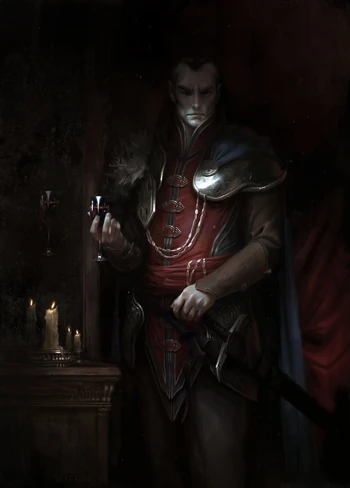
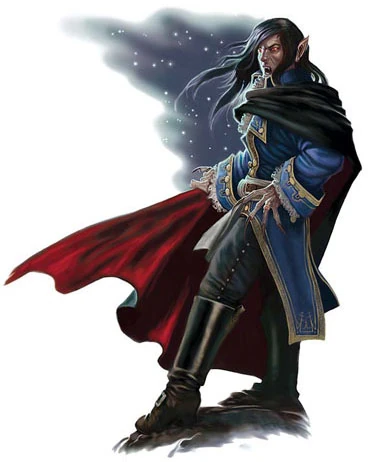
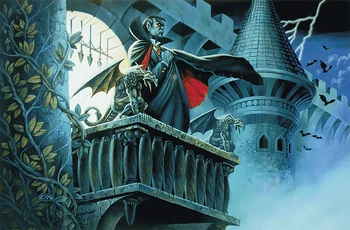
Strahd von Zarovich
Storm King's Thunder
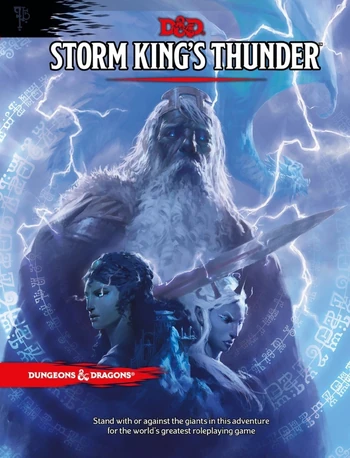
One thing I've always been ambivalent about in D&D lore is giants and the Ordning. And, honestly, up until like around last year when I started doing "Reviewing D&D Monsters" articles, I will admit that I never really cared about them. Sure, it's neat that there are a bunch of these giants, and there's more lore about them beyond being really big bearded dudes, but in retrospect it's mostly because I've never really cared about giant-themed adventures before. Storm King's Thunder is 5E's giant-centric adventure module -- the Ordning, the strict order that all giants from the mightiest storm giants to the lowliest hill giants would order -- is shattered when Hekaton, the Storm Giant, is kidnapped after a coup caused by his two daughters and a blue dragon. This leads adventurers to trying to figure out why the giants are so chaotic and so willing to go around and rampage around and stuff. Pretty epic, actually, and the more I hear about the story of this module the more interested I am to read about it. S'neat!
But since we're reviewing monsters and not the story, and a significant portion of Storm King's Thunder, like Curse of Strahd, consists of 'elite' versions of existing monsters. And it's sure cool to fight like a Storm Giant lieutenant or a shape-shifting Ancient Blue Dragon... but at the same time it doesn't leave me a whole ton to say here.
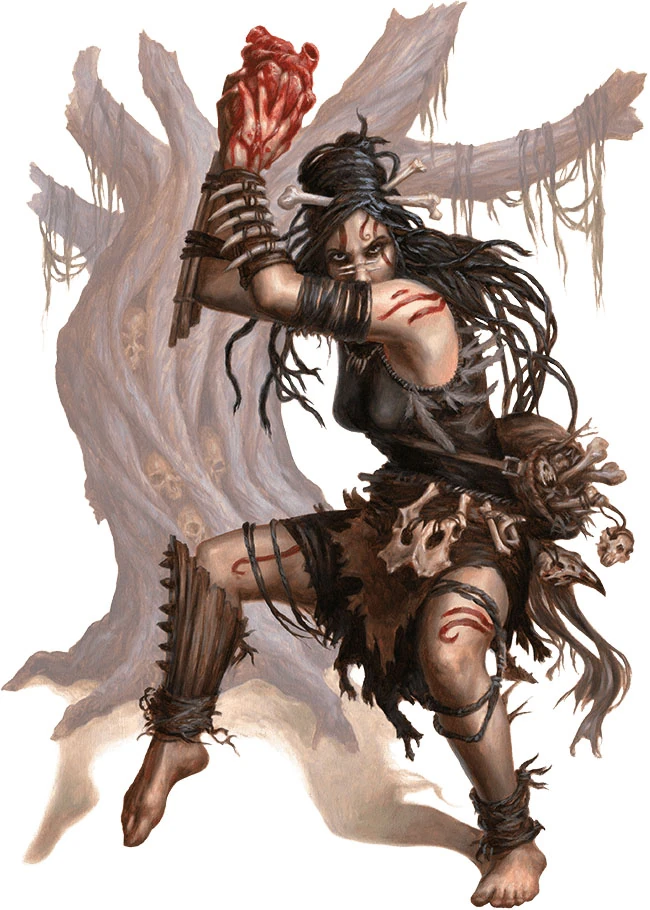
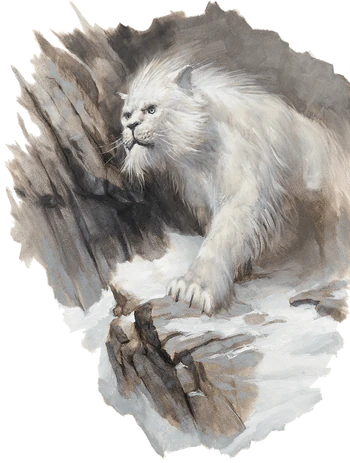
Crag Cat
It's kind of another slightly-modified real world animal, huh? The Crag Cat, also known as the "Hunter of Men" by the people living in the Northlands, is kind of a somewhat-unique predator that can be found in any terrain except deep forests. Its cry is noted to resemble human screams of terror, and it prefers to hunt and kill humans. They can also reflect magic and are 'large' in category, so pretty huge! Depending on the season, the Crag Cat can transform the colour of its fur to suit its surroundings. Crag Cats are also noted to basically wait until its prey is asleep or exhausted. It's neat, but at the same time nothing that I'm clamoring to include in my next campaign.
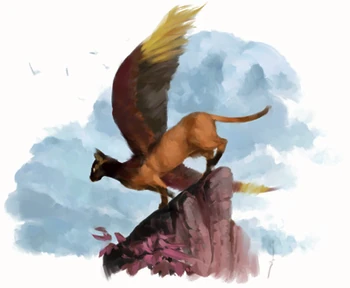
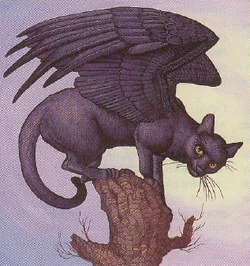
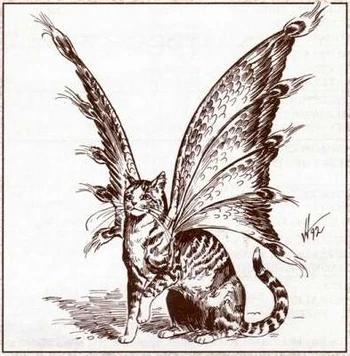

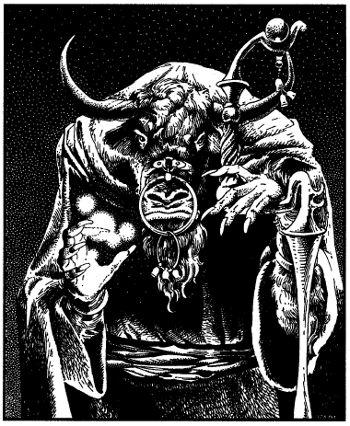
Yakfolk (Yikaria)
...wait, that is it? Okay, I guess Storm King's Thunder had way more giant NPC-enemies than I thought it did. Okay, the last monster in Storm King's Thunder is the Yakfolk, known in their own language as the 'Yikaria'. And... well, they were civilized Minotaurs, but with a yak's head instead of a bull's. The Yakfolk is often treated by outsiders as evil, ruthless savages, and they live in secluded settlements in valleys, plateaus or oases where they rule over humanoid slaves. They are noted to be civilized, well-learned and cultured, but also savage slavers because they consider most tasks beneath them. They basically pretend to be an utopian civilization to distract travelers who wander into their settlements before capturing and enslaving them. They're also obsessed with learning more about dark elemental magic, and they serve 'the Forgotten God' who they worship by killing slaves in ways that correspond to the four elements. Thanks to their god, the Yakfolk are apparently able to enslave and utilize Dao (the earth genies) in combat, and, for some reason, its 'Skin Crawler' ability where they can crawl under another creature's skin to control its body. Oookay?
Tales from the Yawning Portal
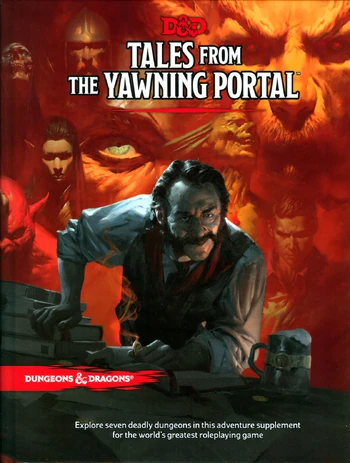
The last book we'll be covering here is Tales of the Yawning Portal, less of an adventure module and more of a 'best of the past' compilation, taking seven of the most popular and most notable adventures in D&D's previous four editions and adapting them to 5th Edition, with the 'tie' between them being that you're hearing this from a bartender telling you these adventures. Or something. You've got Against the Giants (you fight D&D's original three evil giant races); The Hidden Shrine of Tamoachan (vaguely Mayan-inspired hidden jungle temple); Tomb of Horrors (meat-grinder dungeon full of 'fuck you's to the players); White Plume Mountain (a very fun, wacky dungeon with lots of puzzles); The Forge of Fury (retake a dwarf fortress invaded by orcs); The Sunless Citadel (the origin of the Blights???); and Dead in Thay (you go through a dungeon crawl to take down a lich).
A neat eclectic mixture of random adventures. Perhaps not particularly large in terms of story (they're mostly dungeon crawls) and not a whole ton of new monsters... although, admittedly, a good part of it might be because we've covered a lot of the monsters in Volo's Guide to Monsters.
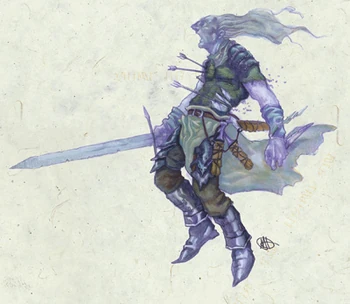
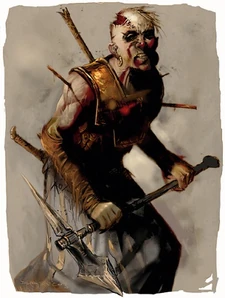
Dread Warrior
The Dread Warriors are a bunch of unique undead servants of the evil Red Wizards that are created as spectral minions and basically take the place of a spellcaster's familiar... but they're actual human-sized ghostly warriors able to hold a sword and stuff. In addition, the Dread Warrior, being a familiar, also transmits all it sees, hears and touches to its owner. Nothing overly interesting, but okay. Apparently in 4E they were zombies.
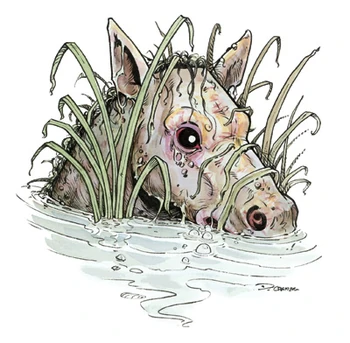
Kelpie
Borrowing its name from the shape-shifting water spirit of Scottish legend, the Kelpie in D&D is a weird one! It's a plant creature, but it's also intelligent, and its true form is apparently a pile of wet seaweed. But it somehow has shapechanging abilities that allow it to appear as either a beautiful human or a horse. However, when adventurers attempt to rescue the human, the Kelpie's true form will then strangle you and drag you underwater and kill you. It's... it's an interesting joke to make about the fact that Kelpie's name contains the word 'kelp'. I do like the fun joke, if nothing else, and while it's kind of somewhat disrespectful to the mythological Kelpie, I felt like the joke was kinda funny and we have a whole lot of regular water spirits already. At least the essence of a shape-shifting water spirit that sometimes looks like a horse is retained.

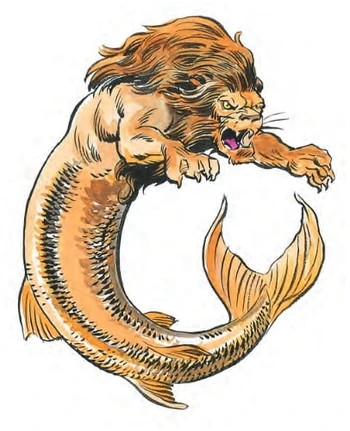
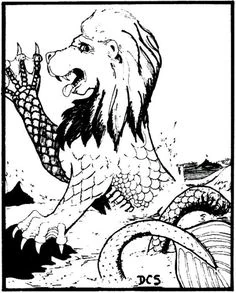
Sea Lion
Speaking of puns, the Sea Lion! No, not the real-life sea lion, which are just weird-looking seals. D&D's Sea Lions are basically mermaid-lions, with the lower body of a fish, and the paws and mane of a lion. It's sort of similar to Singapore's Merlion... except it's called, well, a Sea Lion. Showing up a lot from previous editions (and, well, Tales from the Yawning Portal does recreate older adventures) the Sea Lions are basically just pretty cool underwater predators. Not much is really known about them... and I feel like that's kind of a running theme here.
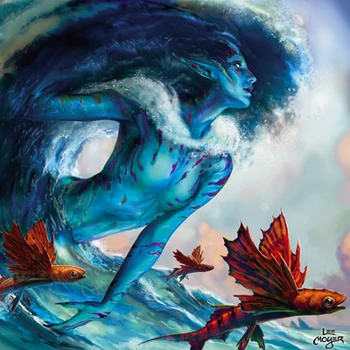
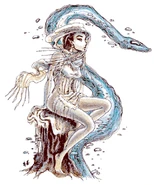

Misc. Enemies
I'm just briefly taking note of the monsters in the bestiary. One of them is an Animated Table, but that's a lot less interesting than the unique animated objects in Curse of Strahd. You can fight a table, though. That's something. The Centaur Mummy actually has a pretty cool artwork, and it's basically what it is -- a centaur turned into a mummy. That's always pretty cool, though, I always do like it that it's so simple but yet also so cool. A minotaur zombie! A yuan-ti abomination revenant! A medusa ghost! The Ooze Master is an undead spellcasting ooze, so... uh, okay?
Containing a bunch of older adventures, there are also a bunch of wacky enemies. The Greater Zombie is just a zombie with extra stats, and the Giant Skeleton is a giant skeleton. And a whole lot of giant animals -- Giant Crayfish, Giant Ice Toad, Giant Lightning Eel and Giant Subterranean Lizard. Sometimes you just gotta fight a bunch of giant animals! The Thorn Slinger is pretty neat, being a plant enemy that lobs thorns at you... but we don't get any real lore or artwork out of it. There's also 'Siren', and I was ready to talk about Greek Sirens... but apparently that's an NPC's name instead of her race. She has very siren-esque abilities regardless, though.
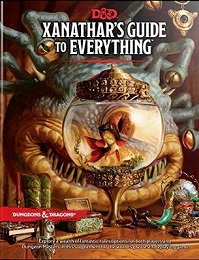


The stats of various creatures that we have covered in Volo's Guide to Monsters were originally printed here, including Vampiric Mist, Leucrotta, Choker, Barghest and Deathlock. We'll talk about the Amphisbaena in Ghosts of Saltmarsh. Various 'reduced threat' variants of Monster Manual monsters are printed here.
The Sunless Citadel:
The Forge of Fury:
Curse of Strahd

So we've got dragons and dragon cults; elementals and elemental cults; plus demons in the Underdark. The next huge sort of villain? The undead, of course. Instead for going for a lich or whatnot, though, we go for a very gothic vibe by having a vampire-themed adventure, a neat, far cry from the more sword-and-magic quasi-medieval-fantasy fare that D&D typically runs on. And unlike most of the previous adventures, Curse of Strahd is a bit more... sandbox-y. I'm not that great at reviewing D&D adventure modules, but I'm told that Curse of Strahd is a fun little sandbox adventure limited into a relatively small area, and the plot basically have you go around, gathering allies and taking down Strahd's minions before taking down the huge vampire count himself. Pretty cool, but the mood and the general gothic-horror vibe is really what makes this module feel so memorable compared to many of the others. I've seen a lot of people say this is their favourite 5E adventure and, hey, gothic horror is cool! I've also seen some people take issue with the Romani-inspired vibe of the vampires, which... I haven't actually read the book, so I'll not comment on that. On with the monsters!

Animated Objects
Only "Strahd's Animated Armor" gets artwork, but in addition to that we've got the "Broom of Animated Attack", the "Guardian Portrait" and what I think is a boss of sorts, "Baba Lysaga's Creeping Hut". Poltergeists and objects moving around without anyone touching them has been a longtime trope of horror, so it's neat that they bothered to give them stats and unique abilities. They could've just copy-pasted the generic Animated Object entry from the Monster Manual, but hey, these are pretty cool! I do really like the description where the Broom of Animated Attack actually pretends to be a helpful (and thematic to the witches-and-vampires setting) flying broom before beating the shit out of you. The Guardian Portrait is like something out of Harry Potter, a portrait whose eyes follow you around. They can't actually hurt you (they are frame pictures on the wall) but what they can do is cast Crown of Madness on your face. Strahd's Animated Armor is... it's got plot significance, and the artwork is very cool (the parts of the armour are actually disconnected and floating!) but it's just a headless piece of armour with a ghostly head. Cool, but nothing that really super-duper appeals to me.
Special mention must go to Baba Lysaga's Creeping Hut. Baba Lysaga himself is a barely-disguised nod to Baba Yaga of Slavic folklore (which inspires a lot of D&D Hags) but the Creeping Hut itself is pretty cool. Baba Lysaga hangs out in a hut within the rotting stump of a giant tree... which she has enchanted, so when she gets sufficiently pissed off at your adventuring party, she can commend the entire stump of the dead tree to rip itself out of the ground and attack you. You're literally fighting a house with a bunch of giant spider legs made out of roots, that's pretty damn cool. I really do love the little detail that if you try to remove the cursed gemstone that powers the Creeping Hut without defeating it first, the Hut grows teeth out of the cavity where the gem is stored and tries to bite off your hand. "How did you lose your hand, man?" "A hut ate it."

Barovian Witch
The Barovian Witches are basically, well, witches that live in the region of Barovia, serving Strahd. They're pretty neat, they're basically lite-Hags but without a lot of the more powerful things that Hags can do (especially after your DM reads Volo's Guide to Monsters) and are just there to have you fight crones and witches. They're part of the gothic horror vibe, I suppose, and look like they're inspired by Snow White's evil queen. There's nothing super-unexpected about them, they're just a combination of a lot of witchy tropes -- deceitful, able to grow sharp claws, can use illusions to look pretty, have cat familiars and stuff... pretty neat. I don't have a whole ton to say here.
The Barovian Witches are basically, well, witches that live in the region of Barovia, serving Strahd. They're pretty neat, they're basically lite-Hags but without a lot of the more powerful things that Hags can do (especially after your DM reads Volo's Guide to Monsters) and are just there to have you fight crones and witches. They're part of the gothic horror vibe, I suppose, and look like they're inspired by Snow White's evil queen. There's nothing super-unexpected about them, they're just a combination of a lot of witchy tropes -- deceitful, able to grow sharp claws, can use illusions to look pretty, have cat familiars and stuff... pretty neat. I don't have a whole ton to say here.
Tree Blight
We don't get artwork for this, sadly. The Blights were already described in the Monster Manual (and indeed, a lot of the monsters from Monster Manual gets featured in a lot of these earlier modules) but we only get to see the smaller, weaker versions -- Vine Blight, Needle Blight and Twig Blight. Now if you remember, the Blights are created out of a vampire-corrupted tree, so of course a particularly powerful one shows up in the vampire-themed adventure module. The Tree Blight is basically described to be big enough to look like a zombie Treant (so my mental image goes to imagine it looking like this), and I do love the description of 'spongy wooden flesh' and 'rubbery wood' (I'm not 100% sure if trees actually turn spongy and rubbery upon death, but okay), and instead of sap, the Tree Blight has blood within its plant-vessels. And somehow this blood causes it to, uh, not burn easily? Okay, sure. The Tree Blight also explicitly has a giant maw filled with sharp teeth that it uses to eat living prey and consume their blood. The description is really cool, and fighting a giant, cursed vampire tree is pretty damn awesome.
We don't get artwork for this, sadly. The Blights were already described in the Monster Manual (and indeed, a lot of the monsters from Monster Manual gets featured in a lot of these earlier modules) but we only get to see the smaller, weaker versions -- Vine Blight, Needle Blight and Twig Blight. Now if you remember, the Blights are created out of a vampire-corrupted tree, so of course a particularly powerful one shows up in the vampire-themed adventure module. The Tree Blight is basically described to be big enough to look like a zombie Treant (so my mental image goes to imagine it looking like this), and I do love the description of 'spongy wooden flesh' and 'rubbery wood' (I'm not 100% sure if trees actually turn spongy and rubbery upon death, but okay), and instead of sap, the Tree Blight has blood within its plant-vessels. And somehow this blood causes it to, uh, not burn easily? Okay, sure. The Tree Blight also explicitly has a giant maw filled with sharp teeth that it uses to eat living prey and consume their blood. The description is really cool, and fighting a giant, cursed vampire tree is pretty damn awesome.



Mongrelfolk
Okay, visually, the 5E Mongrelfolk (a mongrel is a mixed-breed dog) doesn't look particularly interesting. Just some sort of more hideous-looking goblin that, if you didn't tell me, I wouldn't realize that it was meant to be a unique race instead of just a particularly ugly goblin creature. And then you read the description, and the Mongrelfolk are apparently humanoids whose ancestors were transformed via horrific magical transformations into chimera-esque beings with bodies that incorporate the features of various beings -- with, as Curse of Strahd describes, some variants having 'the body shape of a dwarf but the head that combines a cat and a lizard, a hand of a crab, a leg that ends in a hoof', or 'the skins and horns of a cow, the eyes of a spider, frog's legs and a lizard's tail'. That sounds so nasty and awesome, and instead what we got it Dobby's clothed brother.
Far cooler are the artwork from 1E and 2E (the Mongrelman even shows up in 2E's basic Monstrous Manual!) where the actual wretchedness is aptly described. The artwork might be from a more simplistic art style, but the wretchedness of having a cat's leg and a hoof for a leg, and a face that splits diagonally to have features of different animals, and the 1E version having a big crab hand... yeah, these look like more "Mongrelfolk". While looking villainous, they are described as more afraid of normal humanoids and have had a history of being abused and enslaved, so they basically hide out in ruins and deserted buildings and are fiercely territorial and always try to hide their true form with rags or twigs and leaves. Interestingly, someone can restore a Mongrelfolk to its original form... but not the children of a Mongrelfolk? Okay, then. I'm... I dunno. I don't particularly like these guys a whole lot, honestly, but I can't not dislike weird hodgepodge Frankensteined animal-men.
Phantom Warrior
I guess none of the various ghosts and specters of 5E's Monster Manual fits this guy's niche? The Phantom Warrior is a more simple ghost enemy. Where most of 5E's ghosts tend to revolve more around its intangibility or ability to possess you, the Phantom Warrior is content to just beat you to death with his sword. Noted to be created from the souls of warriors who fell on duty, the Phantom Warrior is a spirit that lingers on to willingly serve its master, as opposed to the 'trapped by an unresolved goal' that D&D ghosts have. It can apparently end its undead existence and pass on at any time, with the example given in the bestiary entry noting of a Phantom Warrior guard that continues to guard a wall might pass on after a new guard arrives to relieve him, or if the wall is destroyed. Being a lingering spirit it still doesn't quite have the same amount of memory as a living person, but I do like that as confusing as the names can be, there are a fair amount of different types of undead tossed around that feels like it's built to have roleplay opportunities.

Wereraven
Another one that doesn't have artwork (this one is from 2E) is the Wereraven. Ravens are very appropriate creatures to show up in a horror-themed setting. So are lycanthropes! So yeah, Wereravens exist. They don't quite appear as often as I thought they would, mostly because mammalian lycanthropes are more popular, and Kenkus exist. They're pretty neat as adversaries or NPC's, I suppose? Wereravens are noted to be super-duper cautious, keep to themselves and try to be essentialyl lawful good, not spreading their curse to people who would suffer from it or abuse it. They hang around each other in flocks, or walk around the cities in humanoid forms to donate money to charity and stuff, and basically collect shiny trinkets and baubles to keep them out of the wrong hands.
Strahd Zombie
Sort of a variant of zombies that are created personally by Strahd from the guards of his Castle Ravenloft? I guess the only real differentiating feature is the description about gray-green fleshes and the easiness of how one can dismember limbs from the Strahd Zombie... which, thanks to Strahd's powers, will allow those disconnected limbs to essentially continue attacking even as you hack it into pieces.



Strahd von Zarovich
While I did say that I'm not going to talk about actual characters, Strahd von Zarovich is a vampire lord so I guess I can cheat and talk about him a bit? We've got a bunch of named vampire bosses, but Strahd's got his name on the title of the book and he's in the bestiary section. And he's shown up a lot in previous editions before, so... yeah. Without going too much into his abilities (he's a Vampire Lord and then some) Strahd is basically the embodiment of the cool, calculating immortal vampire count/baron/nobleman that rules from his dark castle... but he's also an immortal vampire that can one-shot your adventuring party as you run around in his realm as you look for ways to properly take down the vampire. Pretty spooky! Imported from the Ravenloft setting, Strahd retains a lot of his suaveness and his completely-in-control personality, has an interesting backstory and an understandable motivation, but is purposefully (it's even on the foreword!) not 'modernized' in any way so that Strahd can be basically a love letter to classic literature vampires. I do feel that while the design is honestly a bit obvious -- just a fancy, handsome-yet-gaunt vampire in a nobleman's outfit -- it works for what Strahd is supposed to be.
_________________________
Storm King's Thunder

One thing I've always been ambivalent about in D&D lore is giants and the Ordning. And, honestly, up until like around last year when I started doing "Reviewing D&D Monsters" articles, I will admit that I never really cared about them. Sure, it's neat that there are a bunch of these giants, and there's more lore about them beyond being really big bearded dudes, but in retrospect it's mostly because I've never really cared about giant-themed adventures before. Storm King's Thunder is 5E's giant-centric adventure module -- the Ordning, the strict order that all giants from the mightiest storm giants to the lowliest hill giants would order -- is shattered when Hekaton, the Storm Giant, is kidnapped after a coup caused by his two daughters and a blue dragon. This leads adventurers to trying to figure out why the giants are so chaotic and so willing to go around and rampage around and stuff. Pretty epic, actually, and the more I hear about the story of this module the more interested I am to read about it. S'neat!
But since we're reviewing monsters and not the story, and a significant portion of Storm King's Thunder, like Curse of Strahd, consists of 'elite' versions of existing monsters. And it's sure cool to fight like a Storm Giant lieutenant or a shape-shifting Ancient Blue Dragon... but at the same time it doesn't leave me a whole ton to say here.

Hulking Crab, Ice Spiders, Purple Wormling & Uthgardt Shaman
I'm going to basically very briefly acknowledge these. And I really do like these sort of things, I just don't have a whole ton to talk about without, well, any artwork or any lore behind them. The Hulking Crab is described as being pretty huge (20 feet) and has ship wreckage on its shell. The Purple Wormling is basically a baby purple worm and doesn't have access to a lot of the Purple Worm's abilities, but it's still a giant worm. Meanwhile, the Ice Spiders and Ice Spider Queen are giant spiders that live in the icy tundra with a couple of extra ice damage. Spiders can, despite their appearances, survive in winter seasons if they are allowed time to prepare. So yeah. The Uthgardt Shamans are members of a human barbarian tribe that hate magic, but still have shamans in their group that commune with their dead with their 'sacred bundle' that they must prepare, and they can use it to create nature-altering effects like making giant ravens hatch out of regular eggs or turning into griffons after drinking horse blood. Okay, sure. I've personally never really been a huge fan of these sort of exaggerated primitive tribes, even less so if they're actually humans.
I'm going to basically very briefly acknowledge these. And I really do like these sort of things, I just don't have a whole ton to talk about without, well, any artwork or any lore behind them. The Hulking Crab is described as being pretty huge (20 feet) and has ship wreckage on its shell. The Purple Wormling is basically a baby purple worm and doesn't have access to a lot of the Purple Worm's abilities, but it's still a giant worm. Meanwhile, the Ice Spiders and Ice Spider Queen are giant spiders that live in the icy tundra with a couple of extra ice damage. Spiders can, despite their appearances, survive in winter seasons if they are allowed time to prepare. So yeah. The Uthgardt Shamans are members of a human barbarian tribe that hate magic, but still have shamans in their group that commune with their dead with their 'sacred bundle' that they must prepare, and they can use it to create nature-altering effects like making giant ravens hatch out of regular eggs or turning into griffons after drinking horse blood. Okay, sure. I've personally never really been a huge fan of these sort of exaggerated primitive tribes, even less so if they're actually humans.

Crag Cat
It's kind of another slightly-modified real world animal, huh? The Crag Cat, also known as the "Hunter of Men" by the people living in the Northlands, is kind of a somewhat-unique predator that can be found in any terrain except deep forests. Its cry is noted to resemble human screams of terror, and it prefers to hunt and kill humans. They can also reflect magic and are 'large' in category, so pretty huge! Depending on the season, the Crag Cat can transform the colour of its fur to suit its surroundings. Crag Cats are also noted to basically wait until its prey is asleep or exhausted. It's neat, but at the same time nothing that I'm clamoring to include in my next campaign.



Tressym
Aw yeah, this is a cool one. I'm not a particularly huge cat person, but I've seen some friends of mine that play D&D with me really love the Tressym. It's a cute housecat with wings! And depending on the edition, it either has cool colourful wings like a tropical bird, badass witchy black wings, or a Fairy-Dragon-esque peacock-inspired butterfly wings. These are basically hand-made by the D&D team to either be pets or familiars, with its 5E lore describing how they get along with rangers and whatnot, and are predisposed to hunt down particularly evil monsters. They will tease dogs, but these are good cats so they won't actually maim them. It's noted that they're highly intelligent, can breed with cats (producing mostly regular kittens) and have a high memory of danger. A very, very neat little flying cat, I actually do like this one a fair bit.
Aw yeah, this is a cool one. I'm not a particularly huge cat person, but I've seen some friends of mine that play D&D with me really love the Tressym. It's a cute housecat with wings! And depending on the edition, it either has cool colourful wings like a tropical bird, badass witchy black wings, or a Fairy-Dragon-esque peacock-inspired butterfly wings. These are basically hand-made by the D&D team to either be pets or familiars, with its 5E lore describing how they get along with rangers and whatnot, and are predisposed to hunt down particularly evil monsters. They will tease dogs, but these are good cats so they won't actually maim them. It's noted that they're highly intelligent, can breed with cats (producing mostly regular kittens) and have a high memory of danger. A very, very neat little flying cat, I actually do like this one a fair bit.


Yakfolk (Yikaria)
...wait, that is it? Okay, I guess Storm King's Thunder had way more giant NPC-enemies than I thought it did. Okay, the last monster in Storm King's Thunder is the Yakfolk, known in their own language as the 'Yikaria'. And... well, they were civilized Minotaurs, but with a yak's head instead of a bull's. The Yakfolk is often treated by outsiders as evil, ruthless savages, and they live in secluded settlements in valleys, plateaus or oases where they rule over humanoid slaves. They are noted to be civilized, well-learned and cultured, but also savage slavers because they consider most tasks beneath them. They basically pretend to be an utopian civilization to distract travelers who wander into their settlements before capturing and enslaving them. They're also obsessed with learning more about dark elemental magic, and they serve 'the Forgotten God' who they worship by killing slaves in ways that correspond to the four elements. Thanks to their god, the Yakfolk are apparently able to enslave and utilize Dao (the earth genies) in combat, and, for some reason, its 'Skin Crawler' ability where they can crawl under another creature's skin to control its body. Oookay?
I dunno. On one hand, hee hee hee, yaks are funny animals and a whole race based on yaks are funny. Also, the whole 'make your prey think they're walking into a yak-people utopia then surprise and enslave them' is a nice little bit of surprise to throw at your players. On the other hand... all this talk about evil, secluded always-evil slaver people and the artwork that gives the Yakfolk some Asian-inspired armour and the yaks themselves being very associated with Tibetans... I dunno. It makes me kind of uncomfortable, is all. I dunno. I'd rather they actually went ahead with the silliness of a yak-man more than anything.
_______________________________
Tales from the Yawning Portal

The last book we'll be covering here is Tales of the Yawning Portal, less of an adventure module and more of a 'best of the past' compilation, taking seven of the most popular and most notable adventures in D&D's previous four editions and adapting them to 5th Edition, with the 'tie' between them being that you're hearing this from a bartender telling you these adventures. Or something. You've got Against the Giants (you fight D&D's original three evil giant races); The Hidden Shrine of Tamoachan (vaguely Mayan-inspired hidden jungle temple); Tomb of Horrors (meat-grinder dungeon full of 'fuck you's to the players); White Plume Mountain (a very fun, wacky dungeon with lots of puzzles); The Forge of Fury (retake a dwarf fortress invaded by orcs); The Sunless Citadel (the origin of the Blights???); and Dead in Thay (you go through a dungeon crawl to take down a lich).
A neat eclectic mixture of random adventures. Perhaps not particularly large in terms of story (they're mostly dungeon crawls) and not a whole ton of new monsters... although, admittedly, a good part of it might be because we've covered a lot of the monsters in Volo's Guide to Monsters.


Dread Warrior
The Dread Warriors are a bunch of unique undead servants of the evil Red Wizards that are created as spectral minions and basically take the place of a spellcaster's familiar... but they're actual human-sized ghostly warriors able to hold a sword and stuff. In addition, the Dread Warrior, being a familiar, also transmits all it sees, hears and touches to its owner. Nothing overly interesting, but okay. Apparently in 4E they were zombies.

Kelpie
Borrowing its name from the shape-shifting water spirit of Scottish legend, the Kelpie in D&D is a weird one! It's a plant creature, but it's also intelligent, and its true form is apparently a pile of wet seaweed. But it somehow has shapechanging abilities that allow it to appear as either a beautiful human or a horse. However, when adventurers attempt to rescue the human, the Kelpie's true form will then strangle you and drag you underwater and kill you. It's... it's an interesting joke to make about the fact that Kelpie's name contains the word 'kelp'. I do like the fun joke, if nothing else, and while it's kind of somewhat disrespectful to the mythological Kelpie, I felt like the joke was kinda funny and we have a whole lot of regular water spirits already. At least the essence of a shape-shifting water spirit that sometimes looks like a horse is retained.


Sea Lion
Speaking of puns, the Sea Lion! No, not the real-life sea lion, which are just weird-looking seals. D&D's Sea Lions are basically mermaid-lions, with the lower body of a fish, and the paws and mane of a lion. It's sort of similar to Singapore's Merlion... except it's called, well, a Sea Lion. Showing up a lot from previous editions (and, well, Tales from the Yawning Portal does recreate older adventures) the Sea Lions are basically just pretty cool underwater predators. Not much is really known about them... and I feel like that's kind of a running theme here.


Nereid
Nereids were basically noted as basically 'nymphs, but bound to the oceans instead of lakes and rivers'. Okay, sure. They are shape-shifting fey that is beautiful, and is noted by older material to often take the form of Tritons. In 2E, Nereids were instead 'higher' water elementals in the same vein of Salamanders. Again, we really don't get a lot of anything about the Nereid, since it just sort of shows up as an optional encounter in a dungeon. It's basically kind of identical to nymphs... which makes sense, because in Greek mythology, Nereids are basically just 'royal' versions of regular nymphs, because the fifty Nereids are the daughters of from Nereus, the Titan of the Sea.
Nereids were basically noted as basically 'nymphs, but bound to the oceans instead of lakes and rivers'. Okay, sure. They are shape-shifting fey that is beautiful, and is noted by older material to often take the form of Tritons. In 2E, Nereids were instead 'higher' water elementals in the same vein of Salamanders. Again, we really don't get a lot of anything about the Nereid, since it just sort of shows up as an optional encounter in a dungeon. It's basically kind of identical to nymphs... which makes sense, because in Greek mythology, Nereids are basically just 'royal' versions of regular nymphs, because the fifty Nereids are the daughters of from Nereus, the Titan of the Sea.
Misc. Enemies
I'm just briefly taking note of the monsters in the bestiary. One of them is an Animated Table, but that's a lot less interesting than the unique animated objects in Curse of Strahd. You can fight a table, though. That's something. The Centaur Mummy actually has a pretty cool artwork, and it's basically what it is -- a centaur turned into a mummy. That's always pretty cool, though, I always do like it that it's so simple but yet also so cool. A minotaur zombie! A yuan-ti abomination revenant! A medusa ghost! The Ooze Master is an undead spellcasting ooze, so... uh, okay?
Containing a bunch of older adventures, there are also a bunch of wacky enemies. The Greater Zombie is just a zombie with extra stats, and the Giant Skeleton is a giant skeleton. And a whole lot of giant animals -- Giant Crayfish, Giant Ice Toad, Giant Lightning Eel and Giant Subterranean Lizard. Sometimes you just gotta fight a bunch of giant animals! The Thorn Slinger is pretty neat, being a plant enemy that lobs thorns at you... but we don't get any real lore or artwork out of it. There's also 'Siren', and I was ready to talk about Greek Sirens... but apparently that's an NPC's name instead of her race. She has very siren-esque abilities regardless, though.

...and that's it. Wow, yeah, this was kinda short. I knew that I wasn't going to have a whole ton to talk about most of 5E's earlier material because they focused more on the strength of the adventure and the actual characters and named villains, but man there aren't a lot, huh? Storm King's Thunder had like two or three real new monsters, while most of Yawning Portal doesn't give us a whole ton of lore or descriptions and they're just stat blocks. Very 1E of it. The sourcebook Xanathar's Guide to Everything shows up, and I do love that Xanathar is a Beholder crime lord... but apparently the guide is to everything but monsters. Anyway, the next book released is Tomb of Annihilation, which... it's going to take an article all on its own, for reasons that will become apparent.
The 5E stats for the creatures in this set of modules.
Curse of Strahd:



- Animated Halbred: Small construct; unaligned; CR 1/4
- Baba Lysaga: Medium humanoid - human shapechanger; chaotic evil; CR 11
- Baba Lysaga's Creeping Hut: Creeping construct; unaligned; CR 11
- Barovian Witch: Medium humanoid - human; chaotic evil; CR 1/2
- Broom of Animated Attack: Small construct; unaligned; CR 1/4
- Ezmerelda d'Avenir: Medium humanoid - human; chaotic good; CR 8
- Guardian Portrait: Medium construct; unaligned; CR 1
- Izek Strazni: Medium humanoid - human; neutral evil; CR 5
- Kasimir Velikov: Medium humanoid - elf; neutral; CR 6
- Kiril Stoyanovich: Medium humanoid - human shapechanger; chaotic evil; CR 3
- Madam Eva: Medium humanoid - human; chaotic neutral; CR 10
- Milivoj: Medium humanoid; neutral; CR 0
- Mongrelfolk: Medium humanoid - mongrelfolk; any alignment; CR 1/4
- Phantom Warrior: Medium undead; any alignment; CR 3
- Pidlwick II: Small construct; neutral evil; CR 1/4
- Rahadin: Medium humanoid - elf; lawful evil; CR 10
- Rictavio: Medium humanoid - human; lawful good; CR 5
- Rose Durst: Medium humanoid; lawful good; CR 5
- Sangzor: Large beast; chaotic evil; CR 1
- Sir Godfrey Gwilym: Medium undead; lawful evil; CR 6
- Snow Maiden: Medium undead; chaotic evil; CR 1
- Strahd von Zarovich: Medium undead - shapechanger; lawful evil; CR 15
- Strahd Zombie: Medium undead; unaligned; CR 1
- Strahd's Animated Armor: Medium construct; lawful evil; CR 6
- The Abbot: Medium celestial; lawful evil; CR 10
- Thorn Durst: Small undead; lawful good; CR 3
- Tree Blight: Huge plant; neutral evil; CR 7
- Vladimir Horngaard: Medium undead; lawful evil; CR 7
- Wereraven: Medium humanoid - human shapechanger; lawful good; CR 2
Storm King's Thunder:



- Aarakocra Simulacrum: Medium humanoid - Aarakocra; neutral good; CR 1/8
- Augrek Brighthelm: Medium humanoid; lawful good; CR 0
- Axe of Mirabar Veteran: Medium humanoid - dwarf; any; CR 3
- Beldora: Medium humanoid; chaotic good; CR 0
- Black Earth Cultist: Medium humanoid - human; neutral evil; CR 2
- Chief Guh: Huge giant; chaotic evil; CR 5
- Chief Kartha-Kaya: Large monstrosity; neutral evil; CR 4
- Cinderhild: Large giant; lawful evil; CR 2
- Claugiyliamatar: Gargantuan dragon; lawful evil; CR 23
- Cloud Giant Child: Medium giant; neutral; CR 0
- Count Thullen: Huge giant; neutral good; CR 10
- Countess Sansuri: Huge giant; neutral evil; CR 11
- Crag Cat: Large beast; unaligned; CR 1
- Cressaro: Huge giant; neutral evil; CR 9
- Darathra Shendrel: Medium humanoid; lawful good; CR 0
- Darz Helgar: Medium humanoid; neutral; CR 0
- Duchess Brimskarda: Huge giant; lawful evil; CR 9
- Duke Zalto: Huge giant; lawful evil; CR 9
- Duvessa Shane: Medium humanoid; lawful good; CR 0
- Eigeron's Spirit: Huge undead; neutral good; CR 4
- Elister Noggins: Small humanoid - gnome; chaotic neutral; CR 2
- Felbarren Dwarf: Medium humanoid - dwarf; lawful good; CR 1/8
- Ghelryn Foehammer: Medium humanoid; lawful good; CR 0
- Great Chief Halric Bonesnapper: Medium humanoid - any; chaotic evil; CR 2
- Harshnag the Grim: Huge giant; chaotic good; CR 9
- Hulking Crab: Huge beast; unaligned; CR 5
- Ice Spider: Large beast; unaligned; CR 1
- Ice Spider Queen: Large beast; unaligned; CR 2
- Imperator Uthor: Huge giant; chaotic good; CR 13
- Iymrith the Dragon: Gargantuan dragon; lawful evil; CR 23
- Jarl Storvald: Huge giant; neutral evil; CR 8
- Jasper Dimmerchasm: Medium humanoid - dwarf; neutral evil; CR 3
- Kayalithica: Huge giant; neutral evil; CR 7
- King Hekaton: Huge giant; chaotic good; CR 13
- Klauth: Gargantuan dragon; chaotic evil; CR 25
- Knight of the Mithral Shield: Medium humanoid - dwarf; lawful good; CR 3
- Lifferlas: Huge plant; unaligned; CR 0
- Lord Khaspere Drylund: Medium humanoid - human; neutral evil; CR 1/8
- Maegera, the Dawn Titan: Gargantuan elemental; chaotic neutral; CR 23
- Markham Southwell: Medium humanoid; lawful good; CR 0
- Miros Xelbrin: Medium humanoid; neutral good; CR 0
- Narth Tezrin: Medium humanoid; chaotic good; CR 0
- Naxene Drathkala: Medium humanoid; neutral good; CR 0
- Nimir: Huge giant; lawful good; CR 13
- Oren Yogilvy: Small humanoid; chaotic good; CR 0
- Orlekto: Huge giant; chaotic evil; CR 13
- Orok: Small humanoid - human; chaotic neutral; CR 1/8
- Othovir: Medium humanoid; lawful neutral; CR 0
- Pig: Medium beast; unaligned; CR 0
- Pow Ming: Medium humanoid - human; neutral; CR 6
- Princess Serissa: Huge giant; chaotic good; CR 13
- Purple Wormling: Large monstrosity; unaligned; CR 2
- Sea Elf: Medium humanoid - elf; chaotic good; CR 1/8
- Shaldoor: Huge giant; chaotic good; CR 13
- Shalvus Martholio: Medium humanoid; neutral; CR 0
- Sheep: Small beast; unaligned; CR 0
- Shield Dwarf: Medium humanoid - dwarf; lawful good; CR 3
- Sir Baric Nylef: Medium humanoid; lawful good; CR 0
- Sirac of Suzail: Medium humanoid; lawful good; CR 0
- Slarkrethel: Gargantuan monstrosity - titan; chaotic evil; CR 25
- Stone Giant of Deadstone Cleft: Huge giant; neutral; CR 7
- Stone Giant Statue: Huge construct; unaligned; CR 0
- Storm Giant Princess: Huge giant; neutral evil; CR 13
- Thunderbeast Skeleton: Huge undead; unaligned; CR 3
- Tressym: Tiny beast; chaotic neutral; CR 0
- Turlang: Huge plant; chaotic good; CR 9
- Urgala Meltimer: Medium humanoid; lawful good; CR 0
- Uthgardt Barbarian Leader: Medium humanoid - human; chaotic neutral; CR 2
- Uthgardt Shaman: Medium humanoid - human; neutral evil; CR 2
- Vaasha: Huge giant; neutral good; CR 13
- Wiri Fleagol: Medium humanoid - gnome; chaotic good; CR 0
- Wood Elf Scout: Medium humanoid - elf; chaotic good; CR 1/2
- Worvil "The Weevil" Forkbeard: Medium humanoid - dwarf; neutral evil; CR 2
- Yakfolk Warrior: Large monstrosity; neutral evil; CR 3
- Yakfolk Priest: Large monstrosity; neutral evil; CR 4
- Young Cloud Giant: Huge giant; neutral good; CR 5
- Zaltember: Large giant; lawful evil; CR 1
- Zephyros: Huge giant; neutral good; CR 13
- Zi Liang: Medium humanoid; chaotic good; CR 0
Tales from the Yawning Portal:
The stats of various creatures that we have covered in Volo's Guide to Monsters were originally printed here, including Vampiric Mist, Leucrotta, Choker, Barghest and Deathlock. We'll talk about the Amphisbaena in Ghosts of Saltmarsh. Various 'reduced threat' variants of Monster Manual monsters are printed here.
The Sunless Citadel:
- Belak the Outcast: Medium human - humanoid; any; CR 2
- Durnn: Medium humanoid - goblinoid; lawful evil; CR 1
- Erky Timbers: Small humanoid - gnome; any; CR 1/4
- Failed Dragonpriest: Large giant; chaotic evil; CR 2
- Goblin Commoner: Small humanoid - goblinoid; any evil; CR 0
- Grenl: Small humanoid - goblinoid; neutral evil; CR 1/4
- Guthash: Medium beast; unaligned; CR 1/4
- Kobold Commoner: Small humanoid - kobold; any; CR 0
- Sharwyn Hucrele: Medium humanoid; neutral evil; CR 1/2
- Sir Braford: Medium humanoid; neutral evil; CR 1/2
- Yusdrayl: Small humanoid; lawful evil; CR 1
The Forge of Fury:
- Animated Table: Large construct; unaligned; CR 2
- Duergar Spy: Medium humanoid - dwarf; lawful evil; CR 2
- Giant Subterranean Lizard: Huge beast; unaligned; CR 4
- Kaarghaz: Medium humanoid - troglodyte; chaotic evil; CR 2
- Nimira: Medium humanoid - dwarf; lawful evil; CR 3
- Ogre Skeleton: Large undead; chaotic evil; CR 2
- Snurrevin: Medium humanoid - dwarf; lawful evil; CR 2
- Amphisbaena: Huge beast; unaligned; CR 3
- Centaur Mummy: Large undead; lawful evil; CR 6
- Giant Crayfish: Large beast; unaligned; CR 2
- Giant Lightning Eel: Large beast; unaligned; CR 3
- Kalka-Kylla: Large monstrosity; neutral; CR 3
- Nereid: Medium fey; any chaotic alignment; CR 2
- Tecuziztecatl: Large monstrosity; neutral; CR 4
- Thorn Slinger: Large plant; unaligned; CR 1/2
- Tloques-Popolocas: Medium undead; neutral evil; CR 5
- Xipe: Large giant; lawful evil; CR 7
- Huge Giant Crab: Huge beast; unaligned; CR 8
- Kelpie: Medium plant; neutral evil; CR 4
- Sea Lion: Large monstrosity; unaligned; CR 5
- Snarla: Medium humanoid - human shapechanger; chaotic evil; CR 5
- Dread Warrior: Medium undead; neutral evil; CR 1
- Elder Black Pudding: Huge ooze; unaligned; CR 4
- Four-Armed Gargoyle: Medium elemental; chaotic evil; CR 2
- Lacedon: Medium undead; chaotic evil; CR 1
- Malformed Kraken: Huge monstrosity; chaotic evil; CR 10
- Ooze Master: Huge undead; lawful evil; CR 10
- Sentient Gray Ooze: Medium ooze; unaligned; CR 1/2
- Sentient Ochre Jelly: Large ooze; unaligned; CR 2
- Tarul Var: Medium undead; neutral evil; CR 13
- Thaxalia: Large aberration; lawful evil; CR 9
- Thayan Apprentice: Medium humanoid - human; any non good alignment; CR 2
- Thayan Warrior: Medium humanoid - human; any non good alignment; CR 2
- White Maw: Gargantuan ooze; chaotic neutral; CR 10
- Chief Nosnra: Huge giant; neutral evil; CR 8
- Estia: Huge giant; neutral; CR 9
- Giant Ice Toad: Large monstrosity; neutral; CR 3
- Hill Giant Sergeant: Huge giant; chaotic evil; CR 5
- Hill Giant Subchief: Huge giant; neutral; CR 7
- Jarl Grugnur: Huge giant; neutral; CR 9
- King Snurre: Huge giant; lawful evil; CR 11
- Large Subterranean Lizard: Huge beast; unaligned; CR 5
- Obmi: Medium humanoid - dwarf; non-good; CR 8
- The Keeper: Huge giant; neutral; CR 7
- Giant Skeleton: Huge undead; neutral evil; CR 7
- Greater Zombie: Medium undead; neutral evil; CR 5
- Siren: Medium fey; chaotic good; CR 3
No comments:
Post a Comment